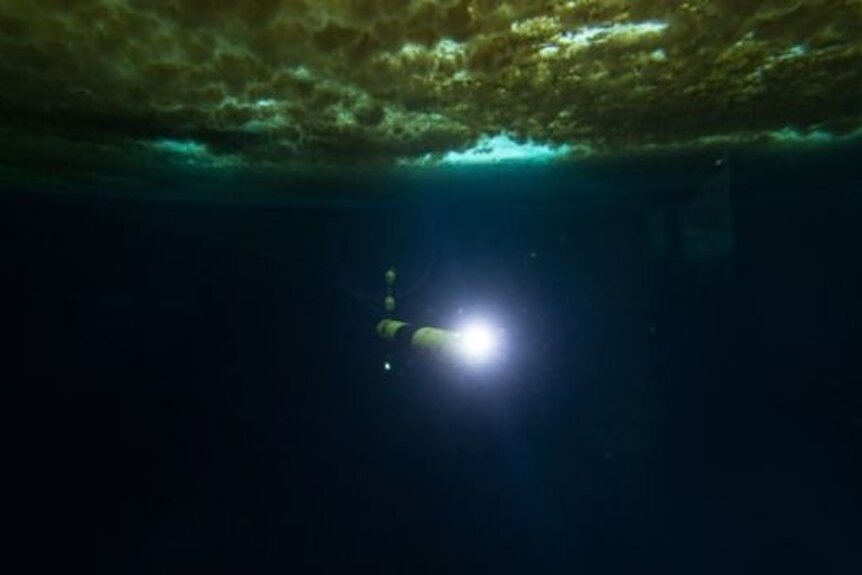Create a free profile to get unlimited access to exclusive videos, sweepstakes, and more!
Scientists sent an underwater robot to figure out what’s killing the Doomsday Glacier
Maybe we can still save it.

John Carpenter’s 1982 science fiction horror film The Thing — based on the John W. Campbell Jr. novella, Who Goes There — takes place in Antarctica, one of the few remaining untamed frontiers on the surface of the Earth. There, a group of researchers encounter a shape-shifting parasite from beyond the stars, which threatens not just the survival of the group, but of every living thing on the planet.
What should have been a quiet if lonely expedition turns into a living nightmare when members of the party discover an advanced alien spacecraft buried in the Antarctic permafrost for a hundred thousand years. They can be forgiven for assuming anything that was once inside is long dead, but they’re wrong. The alien was only slumbering, enjoying an extended hibernation while it waited for its chance. A chance, which has just arrived. The Thing takes the shape of dogs or people, anything alive, transforming them into horrific monsters with mouths in their abdomens and bent tentacles everywhere else. Once they realize what’s happening, the scrappy crew of this Antarctic expedition becomes the only thing standing between the rest of the world and doomsday.
RELATED: Are recent UFO sightings evidence of secret alien visitation? (probably not)
Despite what you might have seen on the news lately, there’s no good evidence that aliens are walking the earth, even the most frigid parts of it. But recent research has more clearly revealed a very real threat at Antarctica’s Thwaites ice shelf.
Thwaites is one of the world’s largest ice shelves in the world and a significant portion of it is supported by land, which keeps it held partially out of the water. Generally speaking, we want the world’s ice to stay where it is. That’s because ice melting into the oceans has the potential to dramatically change the salinity of the water, impacting ecosystems all over the planet. And chunks of ice falling from the land into the water contribute to sea level rise through displacement or by melting and adding even more liquid water into the mix. Unfortunately, Thwaites didn’t get the memo and is decaying rapidly. If Thwaites melts entirely or breaks away from land and plunges into the sea, it will contribute more than two feet of global sea level rise, earning it the nickname of Doomsday Glacier.
Scientists have been keen for a while to get a better look underneath Thwaites, in the hope of better understanding what’s driving its decline. They recently got their chance, thanks to a 13-foot cylindrical robot called Icefin. To get beneath the shelf, researchers used hot water to carve a narrow hole 1,925 feet (587 meters) through the ice and into the frigid waters below.
Once in the water, Icefin observed that normal melting at the ice-ocean boundary isn’t the primary culprit of ice shelf degradation. In fact, smooth parts of the shelf’s underside appeared to be melting more slowly than scientists expected, which is unequivocally good news. But things were a lot worse where the ice is cracked. Fissures in the ice become larger cracks which eventually shatter and break away from the rest of the shelf and that’s what’s causing the majority of the loss in the places they looked. If Icefin’s observations are indicative of Thwaites’ future, then it might be destined to crumble rather than shrink and fade.
RELATED: Most frigid place on Earth is way colder than the average temperature of Mars
Slower melting is good news, but rapid crumbling is bad, particularly in terms of sea level rise. Fractures on or near land are pushing more ice into the water, which drives sea level up even if the ice doesn’t melt. If you’ve ever dropped too many ice cubes into a nearly full glass then you’ve seen firsthand the mess too much ice in your water can make.
Even more troubling is the fact that these observations came from the eastern part of Thwaites, which is still stable enough to land an airplane on. The main part of the shelf, however, is breaking up even faster and is too unstable to safely land upon. It’s almost certain that if we were able to get beneath that part of the shelf, we would find conditions much more dire.
If the trajectory of Thwaites isn’t redirected, we’re going to have a massive spill to deal with on all of the world’s figurative countertops and no obvious method of undoing it. That means that the time to act is now, not later. While the Doomsday Glacier is breaking up more quickly than we’d prefer, its total destruction won’t happen for centuries and doesn’t need to happen at all. The situation at Thwaites and the potential global consequences aren’t ideal, but we already knew that. What’s changed now is we have better tools for understanding what’s driving the decay so that we can make plans to slow or stop it. Getting beneath the ice was difficult, but the real work depends on what we do with what we know, and that starts now.
In the grand scheme, we might actually prefer a flesh-eating, body-snatching alien. At least that’s a problem you can solve with a flamethrower. We’re going to watch The Thing.



























